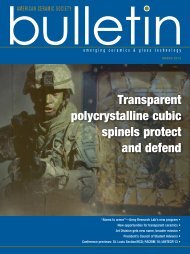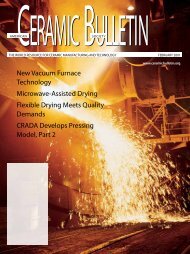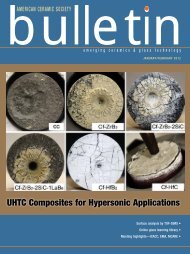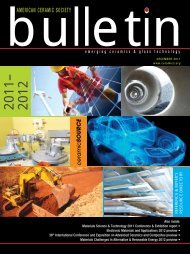American Ceramic Society Bulletin
American Ceramic Society Bulletin
American Ceramic Society Bulletin
Create successful ePaper yourself
Turn your PDF publications into a flip-book with our unique Google optimized e-Paper software.
4<br />
news & trends<br />
those, in eight subjects, including chemistry,<br />
materials science, mathematics,<br />
engineering, computer science, environment<br />
and ecology, earth science and<br />
physics, CAS was ranked in the top five.”<br />
However, Qiu says CAS leaders<br />
are raising the bar. “But the report<br />
acknowledges that there is substantial<br />
room for improvement. For example,<br />
CAS researchers should aim to become<br />
leaders of the international scientific<br />
community, and shift their focus away<br />
from generating as many papers as possible<br />
and toward genuine originality<br />
and innovation,” she reports.<br />
CAS currently has 50,000 employees,<br />
12 branch officers and 103 affiliated<br />
institutes, labs and engineering research<br />
centers.<br />
In regard to revenues generated by<br />
CAS-related companies, president<br />
Yongxiang Lu reports that income was<br />
more than 170 billion RMB (about $26<br />
billion) in 2010. This represents approximately<br />
a 20-fold increase since 2000.<br />
According to the Xinhua news service,<br />
“The CAS deputy president, Bai<br />
Chunli, said 2011 would serve as a pilot<br />
and start-up period for the program,<br />
while breakthroughs in strategically<br />
important scientific fields, such as energy,<br />
health, environment and advanced<br />
materials, were expected in the following<br />
years.”<br />
Qualitatively improving the national<br />
research–development–demonstration–<br />
deployment conveyor belt is a goal<br />
shared by many countries, including<br />
the United States. However, making<br />
these improvements requires significant<br />
and politically difficult strategic decisions<br />
about shaking up the status quo in<br />
regard to funding, infrastructure, status<br />
and accountability. There is no guarantee<br />
that China will succeed, for the<br />
same reasons.<br />
But China is riding on a lot of<br />
momentum from the 1998–2010 period.<br />
CAS has laid out its goals clearly, so it<br />
will be interesting to watch.<br />
Along these lines, it is worth noting<br />
that China will hold its first<br />
International Refractory Production<br />
and Application Conference May<br />
10–12, 2011, in Guangzhou. The conference<br />
is being held in association<br />
with China’s Iron & Steel Association,<br />
Nonferrous Industry Association,<br />
Association of Refractories Industry<br />
and the Metallurgical Council of the<br />
China Council for the Promotion of<br />
International Trade. Aside from applications,<br />
such as blast furnaces, continuous<br />
casters and high-power electric-arc<br />
furnaces, organizers of the conference<br />
say they intend also to cover refractories<br />
for nonferrous metals, cement,<br />
glass and ceramic industries, plus green,<br />
monolithic, low-carbon and noncarbon<br />
refractories.<br />
Visit: Chinese Academy of Sciences<br />
http://english.cas.cn. n<br />
Alfred U. to target leadership<br />
development with new<br />
E-LEAD scholarships for<br />
engineering students<br />
Using $570,000 in NSF seed money,<br />
Alfred University’s Inamori School of<br />
Engineering and the school’s Division<br />
of Student Affairs are launching an<br />
innovative leadership program for engineering<br />
students. The program, called<br />
Engineering Leadership Education and<br />
Development, will begin as a five-year<br />
program to identify and work with a<br />
Alfred University High-Temp Lab.<br />
group of 16 students at the university,<br />
plus help attract high-school-aged<br />
females to the field of engineering.<br />
Doreen Edwards, dean of AU’s engineering<br />
school, explains E-LEAD by<br />
noting that leadership and teamwork<br />
skills are needed for a successful engineering<br />
career. She says, “We hope to<br />
teach students that leadership occurs<br />
at all levels within an organization and<br />
that they can apply their leadership<br />
skills during their very first job as new<br />
engineers. We are particularly interested<br />
in developing leadership around<br />
issues related to gender in the science<br />
and engineering fields.”<br />
The leadership program Edwards and<br />
others are crafting at AU will be based<br />
on what is known as the Social Change<br />
Model. Julia Overton-Healy, director<br />
of the Women’s Leadership Center,<br />
explains that SCM “assumes that there<br />
are core values held within ethical leadership,<br />
and taken together, create change<br />
for the common good. Leadership, then,<br />
is not positional: It becomes a shared<br />
endeavor of committed persons working<br />
toward a common goal.”<br />
Overton-Healy says scholars selected<br />
for E-LEAD will learn specific leadership<br />
skills. Moreover, she notes, the<br />
scholars will be helped in three strategic<br />
areas: identifying their core strengths,<br />
aptitudes and values; understanding<br />
how their experiences, privileges and<br />
<strong>American</strong> <strong>Ceramic</strong> <strong>Society</strong> <strong>Bulletin</strong>, Vol. 90, No. 4<br />
(Credit: Rick McLay; Alfred Univ.)






